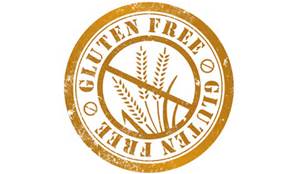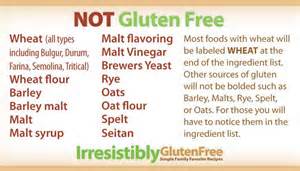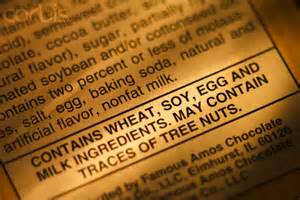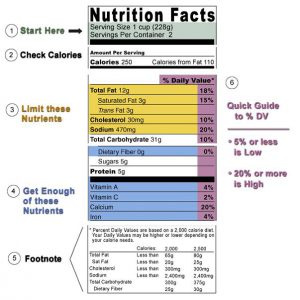Learn How To Read Food Labels
It seems that there are more individuals becoming aware of their gluten sensitivity. It’s very important that anyone with gluten sensitivity or celiac disease, understands what the label is saying on the foods they buy. There are some unsafe ingredients for someone who is sensitive to gluten and they should be avoided.
Another problem is that many people do not even know how to read the nutrition label on the foods they purchase. It’s very important to understand what the ingredients and label information is telling you about the food inside the package. If the ingredients on the label are good and bad for you and you need to know the difference between them.
Our goal is for you to understand the label on the packages when you go into the supermarket. The gluten free nutrition labels will provide the reader of this article with sufficient information on how to read and understand what the data on these labels mean.
Understanding the food labels includes…
- A gluten free definition
- Ingredients to avoid
- Nutrient content descriptors
- How to understand the nutrition label
Understanding Food Labels Video
The topics that will be covered here are below. Select or click on the topic of interest and you will be taken directly to that section. Or, you can scroll down to view them all.
- Gluten Free Labeling Video
- Gluten Free Definition
- Gluten Free Ingredients To Avoid
- How To Understand Nutrition Label
- Nutrient Content Descriptors
- Conclusion
- Shop Gluten Free Nutrition Label Resources
Gluten Free Labeling Video – Mayo Clinic
Back to Gluten Free Nutrition Labels topics.
Back To Top of Page
Gluten Free Definition
The FDA (Food and Drug Administration) has established the following rule on August 2, 2013, for gluten-free foods: “It requires that, in order to use the term “gluten free” on its label, a food must meet all of the requirements of the definition, including that the food must contain less than 20 parts per million of gluten.” The rule also requires foods with the claims “no gluten,” “free of gluten,” and “without gluten“ to meet the definition for “gluten free.”
Back to Gluten Free Nutrition Labels topics.
Back To Top of Page
Gluten Free Ingredients to Avoid
There are certain ingredients that need to be avoided when you have someone in your family who is sensitive to gluten or has celiac disease. If you should find any of these ingredients listed on the label, do not purchase the product as it contains gluten.
The following is a complete list of ingredients to avoid if you have anyone in your family that has celiac disease or is sensitive to gluten (listed in alphabetical order):
Atta flour, Baker’s Yeast, Barley, Barley Grass, Barley Malt, Beer, Bleached Flour, Bran, Bread Flour, Brewer’s Yeast, Bulger (Wheat/Nuts), Chilton, Club Wheat, Common Wheat, Enriched Bleached Flour, Enriched Bleached Wheat Flour, Enriched Flour, Farina, Farina Graham, Farro, Filler, Germ, Graham Flour, Hard Wheat, Wheat Gluten, Wheat Protein, Wheat Starch, Kamut, Kecap (soy sauce), Ketjap (soy sauce), Malt, Malted Barley Flour, Matza, Matzah, Matzo, Matzo Semolina, Meringue, Oriental Wheat, Rice Malt (if soy or barley are used), Pearl Barley, Persian Wheat, Rusk, Seitan, Semolia, Semolia Triticum, Shot Wheat, Spelt, Triticale, Wheat, Wheat Bran Extract, Wheat Germ Extract, Wheat Germ Glycerides, Wheat Germ Oil, Wheat Grass, Wheat Nuts, Wheat Protein, Whole Meal Flour, Wild Einkorn (Triticum boeotictim), Wild Emmer (Triticum dicoccoides).
When you are checking the package and have a doubt about any of the ingredients, always contact the manufacturer first before purchasing. In this way you will know for sure that the food is safe for consumption.
Back to Gluten Free Nutrition Labels topics.
Back To Top of Page
How to Understand Nutrition Label
The biggest and one of the most difficult areas for consumers to understand is the nutrition label on the package. It is vital that you know and understand what these labels mean so that your meals will provide the best possible nutrition for the gluten-sensitive person in your family. Gluten Free individuals need to receive the same nutrients on a daily basis just as those individuals who are not sensitive to gluten also need.
Back to Gluten Free Nutrition Labels topics.
Back To Top of Page
Nutrients
The most common nutrients, such as Total Fat, Cholesterol, and Sodium, are required fields and should be found on all labels. Other nutrients, such as Iron and Vitamin K, are optional and not required to be listed by the manufacturer.
Back to Gluten Free Nutrition Labels topics.
Back To Top of Page
Serving Size
The serving size tries to reflect the amount a person can eat. It must be about the same for like products, which makes it helpful when comparing the nutritional qualities of related foods. Serving sizes are expressed in both common household and metric measures.
Back to Gluten Free Nutrition Labels topics.
Back To Top of Page
Percent Daily Values
Percent Daily Values (PDV) list the levels of important nutrients in a food and how those amounts fit into a daily diet. Percent Daily value is determined on the basis of a 2,000 calorie diet. For example, the total fat of a product is 3 grams, and the 2,000 calorie diet permits 65 grams a day. A simple math procedure would consist of 3g / 65g x 100 Percent = 4.62 Percent or about 5 Percent, which the food label would show if rounded up.
Back to Gluten Free Nutrition Labels topics.
Back To Top of Page
DRV Footnote
The Dietary Reference Values (DRV) is a footnote that reminds consumers of the daily intake of different foods depending on their caloric needs. If one pursues a 2,000 calorie diet, he/she must eat the indicated amounts noted on the right of nutrients noted on the left side of the footnote. For example, if Mary’s daily calorie intake is 2,500 grams, her RDAs would be — 50g of fat, with less than 25g of saturated fat and less than 300 mg of cholesterol, etc. If Bill’s calorie intake is 3,000 grams, he is slightly more active than Mary. These values will vary upon the individual.
Back to Gluten Free Nutrition Labels topics.
Back To Top of Page
Nutrition Facts
This information is always at the top of the label. A breakdown of this information is shown below.
- The Serving Size – This tells you how much one serving is of the product being consumed. For example, 1 cup.
- Servings Per Container – This is the number of servings in the whole package. For example; if the package said 2 servings, and you consumed the whole package, you would be consuming double the numbers that are already printed on the label.
- Amount Per Serving – This is the number of calories per serving of the product. For example; 250 calories and 110 calories from fat. If you ate the whole box you would be consuming 500 calories and 220 calories from fat.
- Total Fat – In our example, this amount is 12g or 18% of the Daily Value (DV). You want to control this nutrient.
- Saturated Fat – In our example, this amount is 3g or 15% of DV. Limit this nutrient.
- Trans Fat – In our example, this amount is 3g. Limit this nutrient.
- Cholesterol – In our example, this amount is 30 mg or 10% of the DV. Limit this nutrient.
- Sodium – In our example, this amount is 470 mg or 20% of DV. Limit this nutrient.
- Total Carbohydrates – In our example, this amount is 31g or 10% of the DV.
- Dietary Fiber – In our example, 0g. The higher the better.
- Sugars – In our example, 5g. You want to control this nutrient.
- Protein – In our example, 5g, or 9% of the DV.
In the last section are vitamins and minerals. Any value that has 20% or more of the DV is high for that nutrient. Anything under 5% is low.
Nutrient Content Descriptors
The regulations also spell out what terms may be used to describe the level of a nutrient in a food and how they can be used. The following are the core terms:
- Free – This term means that a product contains no amount of, or only trivial or “physiologically inconsequential” amounts of, one or more of these components: fat, saturated fat, cholesterol, sodium, sugars, and calories. For example, “calorie-free” means fewer than 5 calories per serving and “sugar-free” and “fat-free” both mean less than 0.5 g per serving. Synonyms for “free” include “without,” “no” and “zero.”
Note: Gluten free means that the product does not contain gluten. However, it does not guarantee that the product was processed on a gluten free machine which can cause cross-contamination for gluten sensitive persons. Contact the manufacturer to ensure that the product was in fact processed on a gluten free machine or one that did not process foods that contained gluten if it’s not stated clearly stated on the label or packaging material.
- Low – This term can be used on foods that can be eaten frequently without exceeding dietary guidelines for one or more of these components: fat, saturated fat, cholesterol, sodium, and calories. There descriptors are defined as follows:
Low-fat: 3g or less per serving
Low-saturated fat: 1g or less per serving
Low-sodium: 140mg or less per serving
Very low sodium: 35mg or less per serving
Low-cholesterol: 20mg or less and 2g or less of saturated fat per serving
Low-calorie: 40 calories or less per serving. Synonyms for low include “little,” “few,” and “low source of.”
Lean and Extra Lean: These terms can be used to describe the fat content of meat, poultry, seafood, and game meats.
- Lean: less than 10g fat, 4.5g or less saturated fat, and less than 95mg cholesterol per serving and per 100g.
- Extra lean: less than 5g fat, less than 2g saturated fat, and less than 95mg cholesterol per serving and per 100g.
- High: This term can be used if the food contains 20 percent or more of the Daily Value for a particular nutrient in a serving.
- Good source – This term means that one serving of a food contains 10 to 19 percent of the Daily Value for a particular nutrient.
- Reduced – This term means that a nutritionally altered product contains at least 25 percent less of a nutrient or of calories than the regular, or reference, product. However, a reduced claim can’t be made on a product if its reference food already meets the requirement for a “low” claim.
- Low – This term means that a food, whether altered or not, contains 25 percent less of a nutrient or of calories than the reference food. For example, pretzels that have 25 percent less fat than potato chips could carry a “less” claim. “Fewer” is an acceptable synonym.
Back to Gluten Free Nutrition Labels topics.
Back To Top of Page
Conclusion
As you can see, the label of the ingredients can be a bit confusing. But, with careful planning, and always reading the information on the package, will keep you from buying anything that can cause health issues for the gluten-sensitive person in the family.
As the meal planner in your home it’s you’re responsibility to ensure that the products you buy and prepare for the gluten free dieter in your family will not have a reaction from the foods you prepare.
Another thing, buying fresh meats, fruits and vegetables are always gluten free with or without a label. It’s the processed foods that you must worry about whether frozen or in a can. Read the labels carefully.
Back to Gluten Free Nutrition Labels topics.
Back To Top of Page
Shop Gluten Free Nutrition Label Resources
You can help yourself to understand food nutrition labels by checking out the resources below.
Back to Gluten Free Nutrition Labels topics.
Back To Top of Page
Go back to the gluten free diet with nutrition home page.




